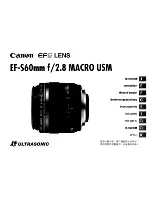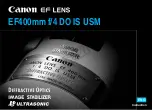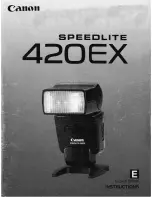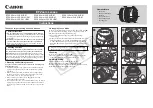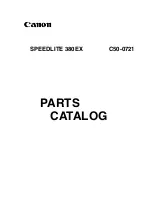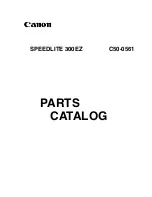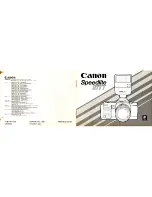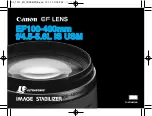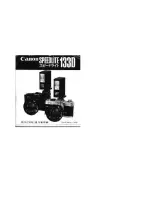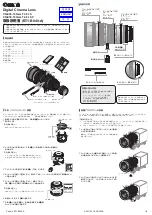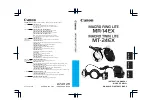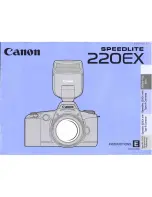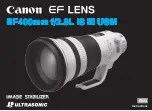
23
multiple coatings to reflect infrared and ultra-
violet rays. It effectively reduces red fringing
and color casts caused by reflections of the
sensor surface. A sophisticated low-pass filter
is also utilized, behind the IR-cut filter, to min-
imize color artifacts such as moiré.
Performance: Dazzling
Speed, Superb Precision
Dual “DIGIC III” Image
Processors
DIGIC, a high-performance imag-
ing processor, has been a major feature of
Canon digital cameras
because of its very fine
image detail, natural
color reproduction and
high-speed signal pro-
cessing. DIGIC III retains
its basic concept and improves upon it with
higher performance and faster speed. For the
EOS-1Ds Mark III’s 21.1 Megapixels, Dual
“DIGIC III” Image Processors work for ultra-
fine detail, natural color reproduction and
high-speed image processing.
The extra power of Dual “DIGIC III” Image
Processors has also allowed analog-to-digital
conversion to improve from 12 to 14 bits per
channel, meaning that tonal gradation for RAW
images is divided into 16,384 separate levels
per channel rather than 4,096. When saved as
a 16-bit TIFF image, the image retains the full
range of tones obtained with 14 bits. Also,
JPEG images, at 8 bits per color, are generated
from the 14-bit data.
Blazingly Fast Shooting
Speed and Outstanding
Burst Rate
The EOS-1Ds Mark III provides a
continuous shooting speed of 5 fps at its full
21.1 Megapixel resolution. It can also capture
up to 56 consecutive full-resolution JPEG
images or up to 12 RAW images in a single
continuous burst. A shutter assembly, an auto-
focus system and Dual “DIGIC III” Image
Processors contribute to the landmark speed
of the EOS-1Ds Mark III.
High-precision AF System
The autofocus system of
the EOS-1Ds Mark III
represents a complete
reconsideration of pro-
fessional autofocus. In addition to a sensor
chip, sophisticated manufacturing technologies
have made it possible to reconfigure the concave
submirror and the cleverly-designed secondary
image formation lens. The result is greater
sensitivity, easier and more logical navigation,
higher precision and significantly better real-
world performance.
In the previous 45-point AF system used by
such cameras as the EOS-1v, EOS-1D, EOS-1Ds,
EOS-1D Mark II, EOS-1Ds Mark II and EOS-1D
Mark II
N
, there were seven cross-type, high-
precision sensors grouped around the center
of the frame. Any of the 45 points could be
selected by navigating around the frame.
This was the configuration of the previous
45-point AF array:
Here is the AF point layout:
Note that the 19 high-precision, cross-type
points are no longer clustered solely in the
center of the frame. The 26 additional assist AF
points are horizontal-line sensitive at f/5.6, are not
user selectable, but can be added to a manually-
chosen point to expand its size, and are also
used in Automatic AF point selection mode.
24
required by the faster signal reading, the out-
put amp’s power consumption has been
reduced. Also during long exposures, power to
the output amp is turned off and the standard
current driving the circuit is also cut off to save
power. In addition, during shooting with Live
View Function, the power distribution for the
signal-reading operation is optimized for more
pinpoint power-saving control.
For the Self Cleaning Sensor Unit, the
infrared-absorption glass is separate from the
three-layer, optical crystal plate. This makes
the dust-shaking plate lighter, saving power
and making it easier to control.
The infrared filter has a hybrid construc-
tion; it has an infrared-absorption glass with
Pixel Size
Microlens Comparison & Opening Ratio
Dichroic mirror
(Reflects infrared rays)
Infrared-absorbing glass
Low-pass filter
(Separates image in vertical direction)
Low-pass filter
(Separates image in horizontal direction)
Phaser layer
(Converts linear polarized light
into circular polarized light)
CMOS sensor
Low-pass Filter Construction
Raising the Bar in
Professional Cameras
EOS-1Ds Mark III:
A Full-Frame Performance
Standard
The EOS-1Ds Mark III incorporates the Canon
CMOS sensor, which delivers approximately
21.1 Megapixels (5616 x 3744 pixels). The
recording area of the sensor is 36.0 x 24.0mm,
which is equivalent to the full-frame size of
the 35mm film format. Compared to typical
smaller digital camera sensors, the Canon
full-frame sensor can accomodate a tremen-
dous pixel count while maintaining larger
individual pixel site size. The EOS-1Ds Mark III
can capture up to 56 consecutive full-resolution
JPEG images or up to 12 RAW images in a
single continuous burst (at 5 fps with 21.1
Megapixel files). Larger sites improve light-
gathering capability, enabling the sensor to
produce a cleaner, more noise-free image.
The Canon full-frame sensor thus delivers
high-resolution images of exacting precision,
with jaw-dropping data density for enhanced
large-output capabilities and post-processing
cropping flexibility.
Full-frame sensors let photographers use
the entire range of superb Canon EF lenses
without a conversion factor, making it possible
to take full advantage of the specific optical
characteristics for which the lenses were
designed. This is an important benefit for
photographers who have a sizable EF lens
collection.
Image Quality
Canon Exclusive CMOS Sensor
Designed and manufactured by Canon, CMOS
single-plate sensors advance the state of the art
in professional SLR sensor design. The imaging
area of the CMOS sensor of EOS-1Ds Mark III
measures 36.0 x 24.0mm (full-frame) — appre-
ciably larger than 28.1 x 18.7mm (APS-H) and
22.2 x 14.8mm (APS-C).
Effective Light-gathering
The EOS-1Ds Mark III sensor
has 21.1 Megapixels.
Individual pixel size on the 1Ds Mark III’s
sensor is 6.4µm.
By optimizing the gap between the on-chip
microlenses and improving the fill factor
(photodiode area divided by total pixel size)
of each pixel, light-gathering efficiency has
been improved.
Wide ISO Range
By combining the splendid image capture
capabilities of the sensor with advanced
Dual “DIGIC III” Image Processors, the EOS-1Ds
Mark III offers extraordinarily wide ISO range,
making it possible to shoot even in previously
impossible lighting conditions. The standard
ISO range of 100–1600, can be extended to a
remarkable low end of 50 and high end of
6400.* More importantly, the low-noise per-
formance at high ISO settings makes the entire
range usable in real-world shooting situations.
*CIPA standard output sensitivity. Recommended exposure index.
Low Noise, High Speed
To achieve even less noise, the EOS-1Ds Mark III
has a feed-through output amp that attains
both high speed and low noise. Low noise is
also achieved with an improved manufacturing
process, an optimized pixel amp and an opti-
mized reading circuit.
The EOS-1Ds Mark III employs a single-line,
8-channel reading. With a faster output amp
and optimized read circuit, a continous shoot-
ing speed of approximately 5 fps is attained.
To minimize the higher power consumption
36.0 mm
24.0
mm
EOS-1Ds Mark III
50
100 - 1600
3200
EOS-1Ds Mark III Full-Frame
CMOS Sensor (Actual Size)
©2009 Vincent Isola
The Technology to Set the Standard
TECHNOLOGY
Time
Diagram of 8-channel
Signal Reading
(C
(C
AF Sensor
5 fps continuous shooting speed (Images simulated)
(C
: f/2.8 sensors
(Cencer AF point is f/4)
: f/5.6 sensors




























